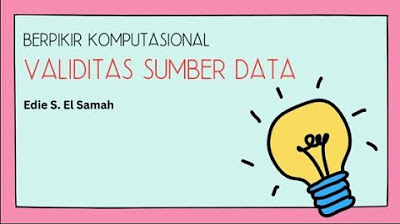01 - Validitas Sumber Data
Summary
TLDRIn this lesson on Data Validity for 10th-grade Informatics, students learn about the importance of using trustworthy and accurate data. The key topics include understanding the different types of data validity (content, construct, criterion, and external), methods to ensure data validity (source evaluation, verification, relevance, recency, and objectivity), and the benefits of valid data in research and decision-making. Real-world examples of credible data sources, such as scientific journals and official reports, are explored. A group activity encourages students to analyze data sources and assess their validity based on set criteria.
Takeaways
- 😀 Data validity refers to the accuracy, trustworthiness, and usefulness of data for its intended purpose.
- 😀 Valid data should be free from errors and bias and should come from credible sources.
- 😀 There are four types of data validity: content validity, construct validity, criterion validity, and external validity.
- 😀 Content validity ensures that the data covers all aspects of the concept being measured.
- 😀 Construct validity relates to how well the data aligns with the underlying theory or concept.
- 😀 Criterion validity assesses how the data relates to other relevant measures.
- 😀 External validity determines whether data results can be generalized to other situations or populations.
- 😀 Methods for ensuring data validity include source evaluation, data verification, relevance, recency, and objectivity.
- 😀 Source evaluation involves assessing the credibility and expertise of the data source.
- 😀 Using up-to-date and relevant data is crucial for ensuring the accuracy and timeliness of information.
- 😀 Valid data benefits decision-making by increasing trust in results, ensuring precision, and helping to formulate effective policies.
Q & A
What is the definition of data validity?
-Data validity refers to the extent to which data obtained from a source is accurate, trustworthy, and can be used for its intended purpose. Valid data is free from errors and bias and comes from sources that can be trusted.
What are the four types of data validity mentioned in the script?
-The four types of data validity mentioned are: 1) Content validity, 2) Construct validity, 3) Criterion validity, and 4) External validity.
Can you explain what content validity means?
-Content validity refers to the extent to which the data covers all aspects of the concept being measured, ensuring that the data is comprehensive and relevant to the subject.
What is the purpose of construct validity?
-Construct validity is the extent to which the data aligns with the underlying theory or concept, ensuring that the data accurately represents the theory it is supposed to measure.
What does criterion validity assess?
-Criterion validity assesses how well the data correlates with other relevant measures, ensuring that the data is consistent with other established metrics.
How is external validity defined?
-External validity refers to the extent to which the results of data can be generalized to other situations or populations, ensuring the findings apply beyond the original context.
What are the methods used to validate data sources?
-The methods to validate data sources include: 1) Source evaluation, 2) Data verification, 3) Ensuring data relevance, 4) Checking the recency of data, and 5) Ensuring objectivity to avoid bias.
Why is source evaluation important in data validity?
-Source evaluation is important because it helps assess the credibility and expertise of the data source, ensuring that the data comes from a reliable and authoritative origin.
What are the benefits of ensuring data validity?
-The benefits of data validity include increasing trust in research results, ensuring precise and accurate decision-making, facilitating better decisions across contexts, and helping in the formulation of effective strategies and policies.
Can you provide examples of valid data sources?
-Examples of valid data sources include: 1) Scientific journals from leading universities or research institutions, 2) Official reports from governments or international organizations, 3) Textbooks written by experts, 4) Statistical data from official bodies like the BPS, and 5) Articles from trusted websites with a good reputation.
Outlines

Esta sección está disponible solo para usuarios con suscripción. Por favor, mejora tu plan para acceder a esta parte.
Mejorar ahoraMindmap

Esta sección está disponible solo para usuarios con suscripción. Por favor, mejora tu plan para acceder a esta parte.
Mejorar ahoraKeywords

Esta sección está disponible solo para usuarios con suscripción. Por favor, mejora tu plan para acceder a esta parte.
Mejorar ahoraHighlights

Esta sección está disponible solo para usuarios con suscripción. Por favor, mejora tu plan para acceder a esta parte.
Mejorar ahoraTranscripts

Esta sección está disponible solo para usuarios con suscripción. Por favor, mejora tu plan para acceder a esta parte.
Mejorar ahoraVer Más Videos Relacionados

01. Berpikir Komputasional - Validitas Sumber Data - Informatika Kelas X

Analisis Data Bagian 1 - Informatika Kelas X

Berpikir Komputasional : Validitas Sumber Data

Praktik Lintas Bidang Informatika Kelas 9

(#1) Mudah Mencari Data dengan Fungsi Vlookup Hlookup, Analisis Data Informatika 8 Kurikulum Merdeka

Kurikulum Merdeka Materi Informatika Kelas 7 Bab 1 Informatika dan Keterampilan Generik
5.0 / 5 (0 votes)
